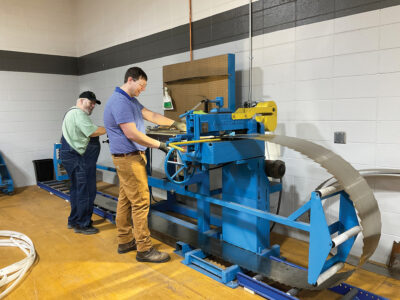I’ve used this column several times to expound on the need for the United States to look to wood products as an off-the-shelf solution for decarbonizing the built environment. There’s another pressing reason for policymakers and designers to look to wood: it’s a renewable resource.
When talking about increasing the use of wood products, the next question we often hear is related to cutting down trees. Isn’t that bad? The United States is the global leader when it comes to managing our forests and the ecosystems, wildlife, and communities that depend on them. Here in the U.S., twice as much wood is being grown each year than is harvested.1
Not to mention, maintaining strong markets for wood products helps to ensure forests are not converted to other uses, motivating landowners to maintain healthy forests that capture carbon. A report by The Nature Conservancy determined that a 1 percent annual demand for wood products could result in more than 49 million acres of new trees being planted.2
With that being said, the question we should be asking ourselves is, “how do we manage this important resource responsibly?” U.S. forest products are helping to ensure our forests remain forests and that our natural resources are being thoughtfully managed. The same cannot be said for other building materials.
A recent report3 from the United Nations Environment Programme (UNEP) warns that the world’s sand, an essential component of concrete, is running out. The report issues a dire warning:
“All countries should be aware that their development is at stake unless they take better care of a common but precious resource, found on many of the world’s beaches, and in our seas.”
Let that sink in. The development of all countries is at stake. Why? Because around 70 percent of the world’s population lives in buildings made at least partly out of concrete.4 Concrete is essentially sand and gravel. The building sector must take seriously the risks associated with extracting these finite materials at the cost of global environmental health.
As our population increases and resources are increasingly constrained, we must prioritize the specification of renewable, carbon-friendly, and sustainable structural materials. Wood is the leader among these.
Increased adoption of wood-based construction products and technologies will displace embodied greenhouse gas emissions associated with other high carbon intensive construction materials, such as concrete and steel. Equally as important, prioritizing the use of renewable materials over finite materials that cannot be regenerated is both a wise use of our resources and the best option for our planet and future generations.
1 Forest Resources of the United States, 2017
– table 36
2 Our Social Impact. Bain & Company
(citing a report from The Nature Conservancy).
3 Sand and Sustainability: 10 Strategic
Recommendations to Avert a Crisis. United
National Environment Programme. April
26, 2022
4 The coming concrete crisis, The Globe &
Mail. August 24, 2018.









